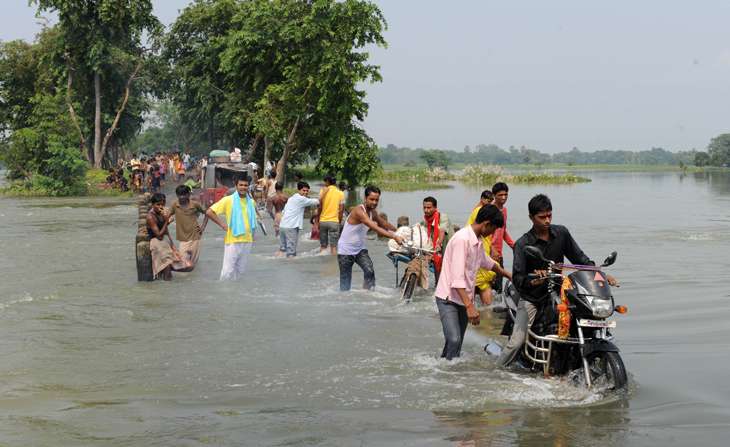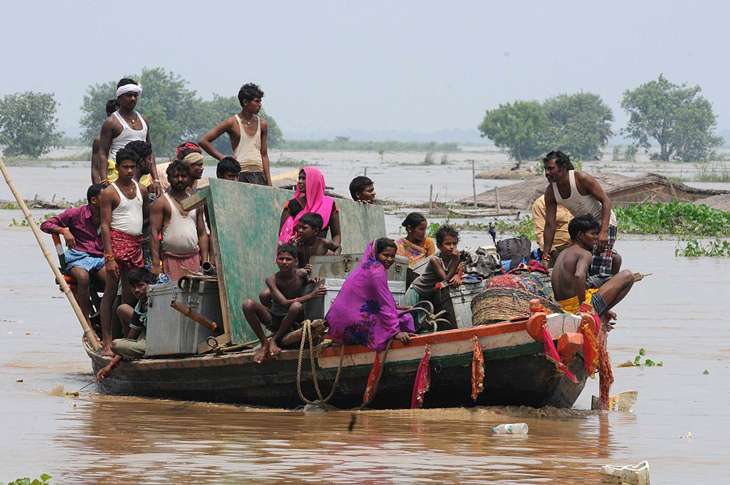Bihar ground report: the bizarre and grim realities of flood politics

"Worst floods since 1975," scream headlines in newspapers and on TV channels.
It's hard to forget the horrific images of past floods - particularly the deluge of 1986-87 that left an indelible mark on this writer.
These are the images that come to mind while we head to Samastipur to take stock of the situation. All 34 panchayats in the district have been severely affected by the floods.
Also read -Bihar floods: Death toll rises to 165, ovr 37. 53 lakh people affected
However, the situation is particularly alarming in four blocks, more so in the Mohiuddinnagar and Mohanpur regions.
A friend who is helping with relief and rescue operations in the area by using his own resources says that the government machinery is moving with its customary lethargy.
Water, water, everywhere

The fields on both sides of the road are inundated. The full extent of devastation only becomes clear only as we leave the main road and head towards the villages.
Carcasses of cows and goats float in the water. The cattle belong to farmers who moved to the safer locations, hoping to return and rescue their livestock after securing their belongings. However, as the water continued to rise, that option was no longer viable.
The stench of death is everywhere.
As far as the eye can see are muddy waters. The Ganga, Gandak, Budhi Gandak, Kamla and Bagmati rivers have all come together as one after their banks were breached, mixing yellow and green water together.
Hapless people on higher rooftops and other elevated platforms cling to the hope that help might arrive soon. Parts of ruined houses, utensils and other goods float about.
"There is no sign of government relief and rescue measures. This is a systematic issue - relief measures are usually restricted areas around dams or higher locations. There too, the government wants the victims in relief camps to return to their homes as soon as possible. Nobody ever reaches the hinterland where the real help is required, " says Kunal Kumar, the president of the flood-aid organisation 'PAX', who is accompanying us on this visit.
The situation is extremely bleak in four blocks of Samastipur. But even though only two panchayats are flooded in Vidyapatinagar, the administration has declared the entire block as flood-affected.
"Floods are a symbol of politics in entire Bihar. You will see floods would never end here," Kunal says with a wry smile on his face. "Floods are a question of death to many, but there are others for whom it is a question of life. Flood relief is nothing but a symbolism in the eternal government system. No government would ever end this misery because bringing relief on the ground means their politics is dead."
Bizarre flood politics
Kunal's statement is a reminder of the time when Chief Minister Nitish Kumar had chosen to return the relief material sent by Narendra Modi eight years ago when he was chief minister of Gujarat. At the time, the Kosi had wreaked havoc in Bihar.
Now Nitish Kumar has been forced to turn to the same leader for help. One cannot find fault with his going to Delhi to plead for assistance from the Prime Minister.
But the chief minister created a new controversy recently by stating that Farakka barrage was the cause of floods and must be removed. Was this statement a sign of the reawakening of a leader and a capable administrator, who also happens to be an engineer by education, or just another political gimmick?
Just another day in Patna
On any given day, you'll see a melee of perspiring men, women and children amid hordes of chaotic bicycles, rickshaws and stray cattle at the Digha Ghat in Patna. A scraggy banner hanging from a corner announces that you have reached the flood relief camp.
Several policemen laze around on the ghats. Far from being a tragedy, floods are an opportunity for entertainment and making money for many here. While some young men are fishing in the water of Ganges, others have decided to make most of 'flood tourism' by opening stalls selling samosas and cigarettes.
A senior UNICEF official who has just returned from a seminar on child labour accompanies us. As we climb up to the new railway track, this mass of humanity swarms about near the soaring waves of the Ganga.
"Tch, tch, tch", the official sympathetically clicks his tongue. "Maharaj, Lalu ne theek kaha tha. The river Ganga has only come to visit her own home. Where would she go when people have encroached her territory?" he surmises.
Right and wrong

"Where would the Ganga go?" is an important question. The assertion that "Lalu is right" is not wrong either. In fact, the political reality of Bihar proves that Lalu is never wrong - even when he tells people to feel fortunate that the mother Ganga has come to their doorsteps.
Perhaps Nitish is also right when he demands the removal of the Farakka barrage. This is by all means a symbolic protest on the part of the Chief Minister considering the fact that the Modi government is going to build 27 more barrages on the Ganga. Besides the Farakka barrage and Tihri barrage, two others are already functional.
Eminent environmentalist and the former convener of Barh Mukti Abhiyan Dinesh Mishra says, "Nitish worked as the agriculture minister and the railways minister at the Centre. He is now the Chief Minister of Bihar and the reality has dawned upon him all of a sudden. He has seen the Kosi river for many decades and is simply putting the ball in the Centre's court. There is nothing wrong with his demand, only the timing is bad."
The Farakka barrage is at the root of the flood problem in many ways. Yet Nitish never thought of solving the issue when he was at the Centre, he adds.
"Nitish Kumar is only interested in presenting himself as Modi's alternative. We have only two major issues with Bangladesh - the enclaves and the Farakka dam. Modi has managed to solve the former one. Now Nitish wants to take the credit for solving the latter," says a senior journalist.
Nitish, he says, is well aware that Farakka barrage is an international issue. Bangladesh has been accusing India of withholding its due share of water and causing calamities like floods and drought within its territory. The Bihar Chief Minister knows it is not possible to remove the Farakka barrage and his exhortation is nothing but an empty rhetoric.
In Mishra's view, the real problem is the silt. He believes that the free flow of rivers must be maintained at all costs. "We are now witnessing a thrust on river linking projects. Nitish Kumar was always a part of this initiative as part of the previous NDA government."
According to Mishra, Nitish has picked up the right issue at the right time. It may not benefit the people on the ground, but it can result in political gains.
Suddenly, the police chase away people from the railway bridge who had gathered around us. I realise the Ganga is also doing the same, driving away the people who have usurped her territory.
Edited by Aleesha Matharu
More in Catch - Bansagar dam is chock-full. Is Bihar on the brink of another flood?
Floods: 19 lakh hit in Assam, 25 lakh in Bihar; 51 people dead so far
First published: 3 September 2016, 9:31 IST




![BJP's Kapil Mishra recreates Shankar Mahadevan’s ‘Breathless’ song to highlight Delhi pollution [WATCH] BJP's Kapil Mishra recreates Shankar Mahadevan’s ‘Breathless’ song to highlight Delhi pollution [WATCH]](https://images.catchnews.com/upload/2022/11/03/kapil-mishra_240884_300x172.png)

![Anupam Kher shares pictures of his toned body on 67th birthday [MUST SEE] Anupam Kher shares pictures of his toned body on 67th birthday [MUST SEE]](https://images.catchnews.com/upload/2022/03/07/Anupam_kher_231145_300x172.jpg)






